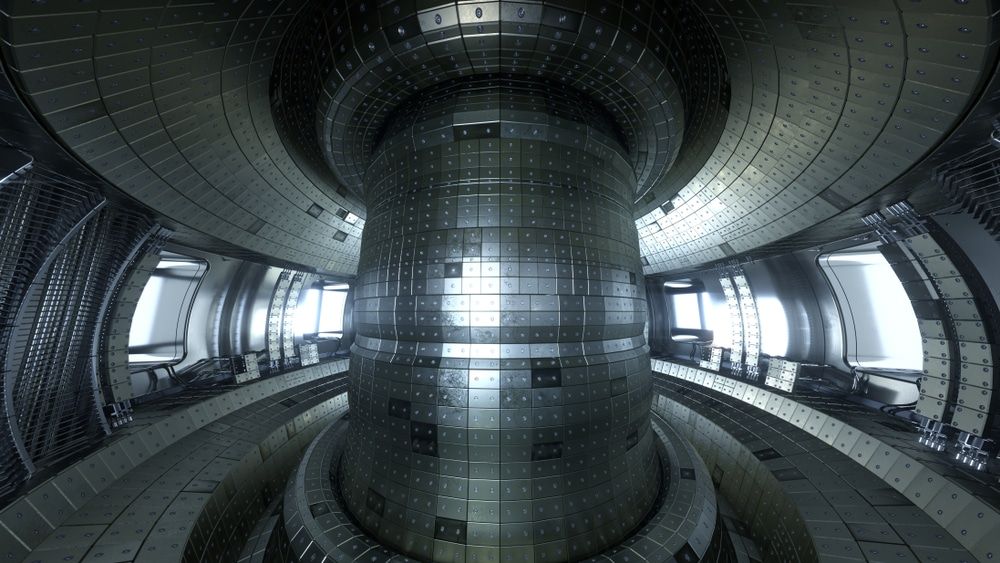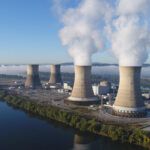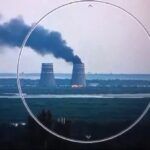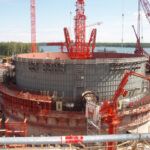Pushing the storage horse with a nuclear waste cart: the spent fuel pool problem
By Robert Alvarez | August 9, 2017

In June, Energy Secretary Rick Perry gave a case of heartburn to US nuclear reactor operators when he testified before the House Energy and Water Appropriations Committee in support of the department’s proposed budget for fiscal 2018. To underscore the need to restart the licensing process at the Yucca Mountain high-level radioactive waste site in Nevada, he mentioned how his visit to the Fukushima accident site powerfully affected him. “Having those spent fuel rods in those cooling ponds in a region of the world that’s inside that ‘Ring of Fire,’ as they call it. And the potential to have a geologic event, we could have a repeat of what happened at Fukushima to some degree.”
While it appears that Perry has become an unlikely ally, of sorts, of my colleagues and me—we have been warning about the cooling-pond problem for several years—the opening of the Yucca Mountain site will not reduce risky storage practices for US nuclear reactor wastes.
Perry correctly pointed to the vulnerabilities of power reactor spent fuel pools to destructive geologic events. He did not, however, mention key steps that need to be taken to significantly reduce the spent fuel pool hazards, well before a radioactive waste repository can open. The most important: a reduction of the density of spent fuel assemblies now stored in these pools, and an expansion of on-site storage of used fuel in hardened “dry casks.” These moves would return the cooling pools to their original purpose—to hold far fewer used fuel assemblies than they currently do, and to hold them only until the assemblies have cooled sufficiently for other forms of storage. During his visit to the Fukushima site, however, Perry may not have learned a major lesson taught by the 2011 earthquake and tsunami at Fukushima: Despite major damage to the rest of the power plant—including the melt-down of three reactor cores—nine dry casks holding 408 spent nuclear fuel assemblies went unscathed.
The pool problem. For more than 30 years, nuclear safety research has shown that severe accidents can occur if a spent fuel cooling pool loses a significant amount of water. If the fuel assemblies in a pool are exposed to air and steam, their zirconium cladding will react exothermically, after several hours or days catching fire in a burn front, ala a forest fire or a fireworks sparkler. (Because of its high reactivity to heat, zirconium was at one time used as a filament in camera flash bulbs.) Such a fire would release a potpourri of radioisotopes; particularly worrisome is the large amount of cesium 137 in spent fuel. Cesium 137 gives off highly penetrating radiation and has a 30-year half-life, meaning it persists in the environment for a long time. It is absorbed and concentrates in the food chain as if it were potassium.
Currently, about 70 percent of some 244,000 spent nuclear fuel assemblies in the United States sit in US power reactor cooling pools, with the remaining 30 percent contained in dry storage casks. About a third of the spent fuel in wet storage sits at decades-old boiling water reactors, in pools built several stories above the ground; the remainder is at pressurized water reactors, where the cooling pools are embedded in the ground.
Following the terrorist attacks of September 11, 2001, my colleagues and I published a paper warning that acts of malice or accidents could cause drainage of spent nuclear fuel pools in the United States, causing spent fuel cladding to catch fire and release catastrophic amounts of long-lived radioactivity—far more than a reactor melt down. The hazard is made worse because the pools are densely packed with irradiated fuel assemblies.
We pointed out that large-scale land contamination would occur if spent nuclear fuel was exposed by a partial drainage or if the pool went completely dry, causing burning fuel assemblies to release a large amount of cesium 137, a result demonstrated after the 1986 reactor accident at Chernobyl, where, more than 30 years later, cesium 137 continues to poison an area roughly half the size of the state of New Jersey, rendering it uninhabitable. To significantly reduce the probability of such an event, we called for an end of the high-density pool storage of used nuclear fuel and the placement of most spent nuclear fuel in dry, hardened storage containers. This change in fuel storage arrangements could be completed within 10 years, we estimated, at a cost of $3.5 to $7 billion.
The receptions of the nuclear industry and the Nuclear Regulatory Commission (NRC) to our study ranged from striking us from Christmas card lists to downright hostility. In fact, one NRC commissioner was so upset after we briefed him that he ordered the staff at the Office Regulatory Research to produce “a hard-hitting critique … that sort of undermines the study deeply.”
NRC suppresses the spent fuel pool problem. In the wake of the September 2001 terror attacks on New York and Washington, Congress commissioned a National Academy of Sciences review to sort out the controversy generated by our study. When the Academy’s report was finalized in 2005, the NRC unsuccessfully tried to suppress it, and to substitute one with its own analysis, which disputed the Academy’s findings. William Colglazier, executive officer of the Academy, successfully forced a public release of a declassified version of its report and took issue with the NRC’s conduct. He emphasized the public’s right to know, stating that “there are substantive disagreements between our committee’s views and the NRC.”
The academy’s report concluded that “[a] loss-of-pool-coolant event resulting from damage or collapse of the pool could have severe consequences… It is not prudent to dismiss nuclear plants, including spent fuel storage facilities, as undesirable targets for terrorists… [U]nder some conditions, a terrorist attack that partially or completely drained a spent fuel pool could lead to a propagating zirconium cladding fire and release large quantities of radioactive materials to the environment… Such fires would create thermal plumes that could potentially transport radioactive aerosols hundreds of miles downwind under appropriate atmospheric conditions.”
The academy panel also found that dry-cask storage offered several advantages over pool storage. Dry-cask storage is a passive system that relies on natural air circulation for cooling, rather than requiring water to be continually pumped into cooling pools to replace water lost to evaporation caused by the hot spent fuel. Also, dry-casks divide the inventory of spent fuel among many discrete, robust containers, rather than concentrating it in a relatively small number of pools.
The Fukushima accident in March 2011 made it clear that the hazard of spent fuel pools was not an abstract issue. Following the earthquake and tsunami, an explosion destroyed the reactor building of unit 4, exposing the pool containing an entire core-worth of freshly discharged spent nuclear fuel to the open air. By sheer luck, an accidental leak from a water line not actually intended to serve the cooling pool prevented water levels from dropping in the pool and thereby causing a major radioactive release.
How the spent fuel pool problem arose. The cooling pools at US nuclear power plants are about 40 feet deep and were originally designed for temporary storage terms of about five years. After that, the used irradiated fuel cores would have cooled sufficiently to be shipped to reprocessing plants where plutonium would be extracted to fuel the next generation of reactors. “Neither the [Atomic Energy Commission, now the Energy Department] nor utilities anticipated the need to store large amounts of spent fuel at operating sites,” the owner of the Millstone reactor station in Connecticut said in 2000. “Large-scale commercial reprocessing never materialized in the United States. As a result, operating nuclear sites were required to cope with ever increasing amounts of irradiated fuel… This has become a fact of life for nuclear power stations.”
After the Carter administration banned reprocessing because of nuclear weapon proliferation concerns, the NRC permitted high density storage in pools and the deployment of dry casks until the Yucca Mountain repository could open, supposedly in 1998. In 2010, however, Yucca Mountain was still a work in progress, and President Obama cancelled it. Now, the Trump administration is seeking $120 million in the 2018 fiscal year to restart the NRC licensing process for the site. Under the most optimistic assumptions, a geologic repository would not open for 30 to 50 years.
Meanwhile, the US reactor fleet has maxed out its wet storage capacity and shows no signs of changing the practice of high density pool storage, even after being forced, by sheer lack of room in the pools, to put more waste in dry storage containers.
The dangers of cooling pool storage. After the Fukushima nuclear disaster, the NRC left it up to reactor operators to provide their own strategies to address what is known as a beyond-design-basis accident, such as a highly destructive earthquake, that caused the loss of water in a spent fuel pool. Some of those strategies seemed less than robust. For instance, the strategy to replace spent fuel pool water at the Columbia Generating Station, a boiling water reactor in Washington that sits in an earthquake prone area, involves connecting a pumper fire truck to two spray ponds, where water is cooled before reuse. More than 600 feet of hosing is required; it would snake from the pumper truck up several flights of steps, reaching the spent fuel pool about 195 feet above the ground and, supposedly, pushing 300 to 600 gallons of water per minute into the pool.
Satisfied with the steps taken by US reactor operators, NRC officials told a panel of the National Academy of Science in 2013 that “no early fatalities are predicted in any scenarios” studied in response to the Fukushima disaster. A pool fire, the NRC said, would result in “exposures to very lightly contaminated areas for which doses are small enough to be considered habitable.”
In 2007, however, the commission provided a radically different assessment to emergency responders seeking to rapidly determine the degree and extent of nuclear accidents. An important part of its preparedness and response capabilities is a computer model that the NRC and emergency responders must rely upon for a rapid evaluation of the radiological impacts from accidents at nuclear power plants, spent fuel storage pools, and casks.
The NRC’s instructional workbook for the model lays out a scenario at Unit 2 of the San Onofre nuclear plant in Southern California. Under that scenario, plant staff report that an earthquake has cracked a spent fuel pool, which is losing water that appears to be flowing into a sink hole. A malfunctioning pump has prevented staff from refilling the pool. “The water dropped to the top of the fuel at 8:49 a.m., and appears likely to continue dropping,” the workbook scenario says. “Estimates are that the fuel will be fully uncovered by 11:00 a.m. The pool has high-density racking and contains one batch of fuel that was unloaded from the reactor only 2 weeks earlier.”
Based on this scenario, the NRC report estimates that within six hours of pool drainage, the spent fuel cladding will catch fire, releasing approximately 86 million curies of radioactive material into the atmosphere. Of that, about 30 percent of the radio-cesium in the spent fuel (roughly 40 million curies) would be released—more than 150 percent of the amount released by all atmospheric nuclear weapons tests. An area within a 10-mile radius—encompassing 314 square-miles of land and offshore waters—could be lethally contaminated, including the world’s largest US Marine Corps base at Camp Pendleton and the city of San Clemente. The resulting doses, based on the results from NRC’s model, could be lethal within a 10 mile radius of the power plant—and comparable to those received by the Japanese atomic bomb survivors ten miles away.
The two operating reactors at San Onofre were permanently shut down in 2013. A decommissioning and fuel handling plan filed in 2014 suggests that the 2,668 used fuel assemblies then in wet storage will be transferred to dry storage—but that process would not be complete until 2019.
In May 2016, for the second time, a National Academy of Science panel refuted the NRC’s expressions of confidence in the safety of spent fuel pools. Finding flaws in the agency’s technical assumptions, the panel stated that the loss of spent fuel pool cooling at the Fukushima site “should serve as a wake-up call to nuclear plant operators and regulators about the critical importance of having robust and redundant means to measure, maintain, and, when necessary, restore pool cooling.” The members also urged the NRC to “ensure that power plant operators take prompt and effective measures to reduce the consequences of loss-of-pool-coolant events in spent fuel pools that could result in propagating zirconium cladding fires.”
This was followed up this year by my colleagues, who reported in Science magazine that in its 2014 analysis, the NRC manipulated its modeling to downplay the consequences of a spent nuclear fuel pool fire. If such a fire occurred at the Limerick boiling water reactor near Philadelphia, my colleagues reported, it could release enough radioactive material to contaminate an area twice the size of New Jersey. Radioactive fallout could force approximately eight million people to relocate and result in $2 trillion in damages—making the event an order of magnitude costlier than Hurricane Katrina. Other than a major war, there are few, if any, technological mishaps that can hold a candle to the consequences of a major power reactor spent fuel pool fire.
Naoto Kan, Japan’s prime minister when the Fukushima accident occurred, made this point very clear in a PBS documentary early this year. After being informed about the consequences if the spent fuel in Fukushima Unit 4 pool had caught fire, he said, “[W]e would have to evacuate 50 million people. It would have been like losing a major war… I feared decades of upheaval would follow and would mean the end of the State of Japan.”
What needs to happen now. For all of Rick Perry’s angst over the need to reauthorize Yucca Mountain, the Trump administration zeroed out a $65 million-line item in the Energy Department’s fiscal 2018 budget that would have gone toward improving the safety and security of stored spent nuclear fuel. These funds are needed to deal with critical issues that must be resolved, if the United States is to safely store its used nuclear fuel.
In addition to pushing to reopen the Yucca Mountain site, members of Congress with closed reactors in their states are seeking to establish a consolidated interim storage site. Energy Department-sponsored research indicates that it may take about 15 years after a license application is filed with the NRC before an interim storage site is opened at an expense of $22.3 billion. During this time, it’s likely that more reactors will be shuttered.
Nearly 20 percent of the nation’s spent nuclear fuel is located at closed or soon-to-be closed reactors. Recently, a Bloomberg energy finance report suggested that more reactor closures may be on the horizon: “More than half of America’s nuclear reactors are bleeding cash, racking up losses totaling about $2.9 billion a year.” US commercial power reactors have generated about 75 percent of the global inventory of spent nuclear fuel; the accelerated closure of more US reactors could seriously affect a system that lacks the necessary planning and logistics for the management of a rapidly growing inventory of wastes.
Transporting spent nuclear fuel is further complicated because the storage at reactor sites involves a complicated mix of containers; each spent nuclear fuel canister system has its own unique challenges. The NRC has licensed 51 different designs for dry cask storage, 13 which are for storage only and not for transport. As many as 11,800 onsite dry storage canisters may have to be reopened or repackaged before transport to either a centralized interim storage facility or to a permanent repository.
The current generation of dry casks was intended for short-term on-site storage—not for direct disposal in a geological repository. None of the dry casks storing spent nuclear fuel is licensed for long-term disposal. The large storage canisters in use at power plants can place a major burden on a geological repository in terms of handling and emplacement of cumbersome packages with high heat loads and high radioactivity. Indeed, repackaging for disposal may require tens of thousands of smaller canisters, and at an estimated average cost of $50,000 to $87,000 per used fuel assembly, repackaging won’t be cheap. At the same time, spent fuel pools are integral to enable repackaging for transport and geological emplacement.
None of these essential preconditions to a permanent high-level nuclear waste repository—and many more involving transportation arrangements and accommodation for hotter, “high-burnup” spent fuel —is being spelled out to the public or the Congress, even though addressing them will cost billions of dollars. Meanwhile, members of Congress are seeking to transfer ownership of the spent fuel at the reactor sites to the government. Under current law, title to the spent nuclear fuel is transferred to the federal government only after it enters the gate of an opened geologic repository. All expenses before then are to be borne by the reactor owners.
In the rush to move wastes from closed reactor sites, several issues with major financial implications need to be addressed. How much will it cost if the federal government assumes ownership at the reactor site for spent nuclear fuel transportation, storage, repackaging, and disposal?
In January 1959, 15 years after the dawn of the nuclear age, Abel Wolman, a professor at John Hopkins University, described the extraordinary nature of high-level radioactive wastes at the first congressional inquiry into the subject. “Their toxicity in general terms, both radioactive and chemical, is greater by far than any industrial material with which we have hitherto dealt in this or in any other country” he said. “We dispose of the wastes of almost every industry in the United States by actual conversion into harmless material,” Wolman stressed, “This is the first series of wastes of any industry where that kind of disposal is nonexistent.”
Wolman’s observation still holds true. The best we can do is to attempt to contain and isolate these wastes from the human environment on a time scale that transcends the geologic era defining the presence of human civilization. Projecting what might happen at the Yucca Mountain site over the time frame it remains open, given that nothing of this scale has ever been tried, contains formidable elements of speculation.
For instance, it will take about 50 years to fill the repository. After that, according to the Energy Department’s license application for the Yucca Mountain site, the repository will require forced ventilation for 100 years to remove decay heat that could impact waste containers and the geology of the site.
Maintenance of power and rail and other transport systems to support the repository will be required for about 150 years. This support includes the installation, in a dangerous high temperature environment, of more than 11,000 large drip shields, each weighing about five metric tons, to prevent moisture from corroding the waste packaging. The drip shields would require nearly two-thirds of the world’s current annual consumption of titanium.
Despite Perry’s efforts to restart the Yucca Mountain long-term storage project, Senate appropriators were unconvinced. They recently cut the $120 million proposed by the Trump administration to fund the project.
Eventually, the United States will have to create a long-term repository for its high-level commercial nuclear wastes. In the meantime—right now—the United States needs to stop putting the disposal cart before the safe storage horse, and to greatly reduce the amount of used nuclear fuel packed in vulnerable nuclear power plant cooling pools that were never intended to store radioactive waste for long periods of time.
Together, we make the world safer.
The Bulletin elevates expert voices above the noise. But as an independent nonprofit organization, our operations depend on the support of readers like you. Help us continue to deliver quality journalism that holds leaders accountable. Your support of our work at any level is important. In return, we promise our coverage will be understandable, influential, vigilant, solution-oriented, and fair-minded. Together we can make a difference.
Topics: Columnists, Nuclear Energy
















Thanks so much for the detailed explanation of the messiness of high level nuclear waste. What a travesty we did not go with the Paley Commission in the early 1950s (the solar route), which was essentially replaced by the Atoms for Peace program.
Thank you for your very enlightening article Robert. The authorities should have known better for 70years, but they daren’t admit the danger, or risk. Instead they wait a while and cross their fingers till it’s somebody else’s problem. I live in England a few miles from Sellafield where all the UKs nuclear waste is stored. A lot of the oldest stuff is in ponds where it was dumped decades ago. No one in the UK talks about it, no one seems to care? They implicitly believe that they”Authorities” have it covered. Ha! I’m sure what you say equally applies in… Read more »